| Plant Kingdom Concepts Files |
| Plant Kingdom Master Files |
| Plant Kingdom NCERT Crisp |
| Plant Kingdom Notes 1 |
| Plant Kingdom Note 2 |
| Plant Kingdom Note 3 |
Plant Kingdom
Table of Content
- Definition of Plant Kingdom
- Algae
- Bryophytes
- Pteridophytes
- Gymnosperms
- Angiosperms
- Plant life cycles and alternation of generations
Definition of Plant Kingdom
Almost all living organisms depends on plants for food. Plants differ from animals in the following features-
- Presence of cell wall in plants.
- Plants are mostly autotrophic in nature.
- Plants contain chloroplast which is major component for photosynthesis.
- Plants are immotile.
Different classification was proposed to classify plants. Earlier the most common classification system used was based on certain vegetative or morphological characters. Such system was known as artificial system of classification. It was proposed by Linnaeus. Another system of classification was known as natural system of classification. It was based on internal features.
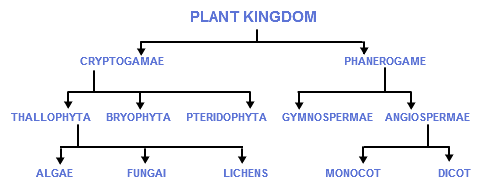
Fig.1. Classification of plants
Algae
Algae belong to Thallophyta. They are autotrophic, photosynthetic organisms. They are found in variety of habitats such as soils, wood, and moist places. They vary in size and form. They can be unicellular such as Chlamydomonas, colonial such as Volvox, filamentous such as Ulothrix.
Reproduction can be vegetative, asexual, or sexual. Vegetative reproduction occurs via fragmentation. Each fragment formed after fragmentation give rise to a new thallus. Asexual reproduction occurs via motile spores known as Zoospores. These spores on germination give rise to a new plant or thallus. Zoospores can be flagellated or non-flagellated. Flagellated zoospores are found in Chlamydomonas and non-flagellated zoospores are found in Spirogyra. Gametes of Chlamydomonas and Spirogyra are similar in size. Such gametes are known as isogamous gametes.
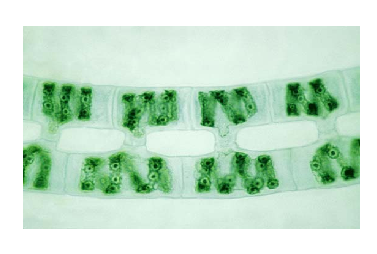
Fig.2. Spirogyra
But if gametes are of different sizes, such gametes are known as anisogamous. Fusion between small, motile male gamete and large, non-motile female gamete is known as oogamous. For example, Volvox.
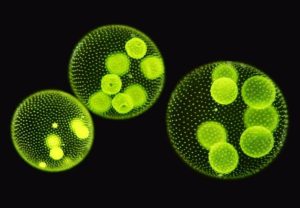
Fig.3. Volvox
Brown and red algae produce hydrocolloids. Hydrocolloids are water holding substances. For example, Algin and Carrageenan.
Uses of Algae
- They are the primary producers in the aquatic environment.
- Agar obtained from algae Gelidium and Gracilaria are used in preparation of jellies and ice-creams.
- Chlorella is used as food supplements by space travelers.
- Some algae are used as fertilizers.
- Algae are used in sewage treatment, that is, pollution control.
Algae are divided into following classes-
Chlorophyceae
- Members of chlorophyceae are known as green algae.
- They are unicellular organisms. The exists as filaments or as colonies.
- The main pigment found is chlorophyll a and chlorophyll b.
- The chloroplast found in these members vary in shape such as reticulate, discoid, spiral, cup-shaped etc.
- The food is stored in bodies known as pyrenoids. Pyrenoids store proteins and starch.
- They have cell wall made up of cellulose with outer layer of pectin.
- Vegetation reproduction occurs by fragmentation.
- Asexual reproduction occurs by flagellated zoospores.
- For example, Volvox, Ulothrix, Spirogyra, Chara and Chlamydomonas.
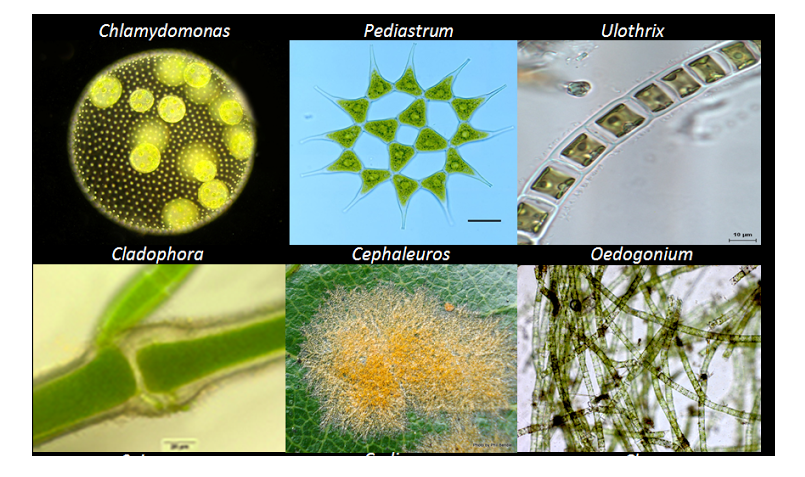
Fig.4. Examples of Chlorophyceae
Phaeophyceae
- The members of this class are known as Brown algae.
- They can be branched or filamentous in existence.
- The main pigments found are chlorophyll a, chlorophyll c, xanthophyll, and carotenoids.
- Food is stored in the form of Laminarin and mannitol.
- They have cell wall made up of cellulose with outer gelatinous coating of algin.
- Leaf-like structure is known as fronds which are photosynthetic in nature.
- Plant body is attached to the substratum via holdfast.
- Asexual reproduction occurs by Zoospores.
- For example, Fucus, Sargassum, Laminaria etc.
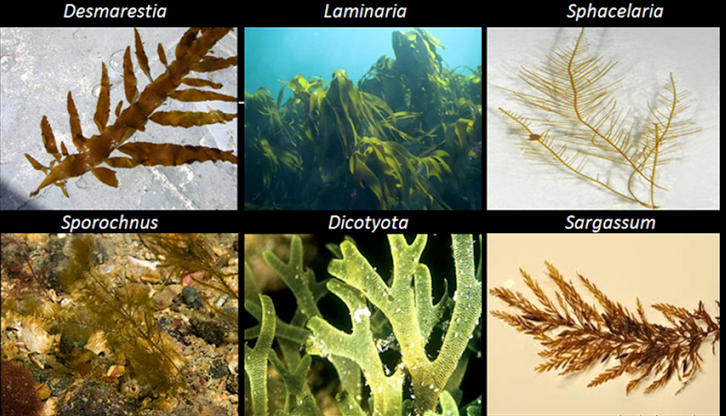
Fig.5. Members of Phaeophyceae.
Rhodophyceae
- Members of this class are known as red algae.
- They appear red due to the presence of pigment known as phycoerythrin which gives red color to it.
- The thallus is multicellular in nature.
- The stored food material is in the form of floridean starch.
- Vegetative reproduction occurs by fragmentation.
- Asexual reproduction occurs by non-motile spores and sexual reproduction occurs by non-motile gametes.
- For example, Gracilaria, Polysiphonia, Gelidium etc.

Fig.6. Members of Rhodophyceae
Bryophytes
Bryophytes includes liverworts and mosses. They use water for sexual reproduction so known as “amphibians of the plant kingdom”.
- Plant body is thallus-like, prostrate or erect.
- They possess hairy-like structure known as Rhizoids.
- Absence of true roots, stems or leaves.
- Main plant body of bryophyte is haploid in nature. This is known as gametophyte which produces gametes.
- Presence of multicellular sex organs.
- Female sex organ is known as archegonium which is flask shaped. It produces egg.
- Male sex organ is known as antheridium which produce male gametes known as antherozoids.
- As fertilization occurs in water, antherozoids are released in water to reach the archegonia.
- Fertilization of egg and antherozoids forms zygote. Zygote matures into sporophyte.
- Sporophyte is dependent on gametophyte.
- They provide food to birds and other animals.
- Certain members of Bryophytes are used as packaging material such as Sphagnum.
Bryophytes are further divided into Liverworts and mosses.
Liverworts are found in moist, shady places. For example, Marchantia. Plant body of Marchantia is thalloid in nature. Asexual reproduction occurs by fragmentation. Reproduction occurs by specialized structures known as gemmae. Gemmae are multicellular structure which develop in small receptacles known as gemmae cups. Gemmae after maturation gets detached from the parent body and develops into new individuals.
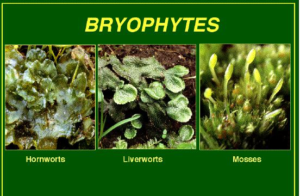
Fig.7. Divisions of Bryophytes
Mosses are flowerless plants. There life cycle includes two stages-Protonema and leafy stage. The first stage is known as protonema which is formed from spore. The leafy stage develops from secondary protonema. Presence of multicellular and branched rhizoids. Vegetative reproduction occurs by fragmentation and budding. For example, Funaria, Sphagnum etc.
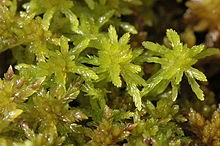
Fig.8. Sphagnum
Pteridophytes
Horsetails and ferns are members of pteridophytes. They are the vascular plants, that is, with xylem and phloem. They do not produce flowers or seeds.
- They have roots and leaves.
- Life cycle includes alternation of generation. Both haploid and diploid phases.
- Small leaves of pteridophytes are known as microphyll, such as in Selaginella. Large leaves found in Ferns are known as macrophylls.
- Leaves that bear the sporangia are known as sporophyll. Sometimes sporophylls formed a compact structure known as strobili or cones.
- Spores on germination forms prothallus.
- Female sex organ is known as archegonium.
- Male sex organ is known as antheridum.
- Water is essential for fertilization.
- Spores formed can be homosporous (spores of similar kind) or heterosporous (spores of different kind). Homosporous spores are found in majority of pteridophytes and spores found in Selaginella and Salvinia are heterosporous.
- The four classes of Pteridophytes are as follows- Pteropsida, Lycopsida, Psilopsida and Sphenopsida.
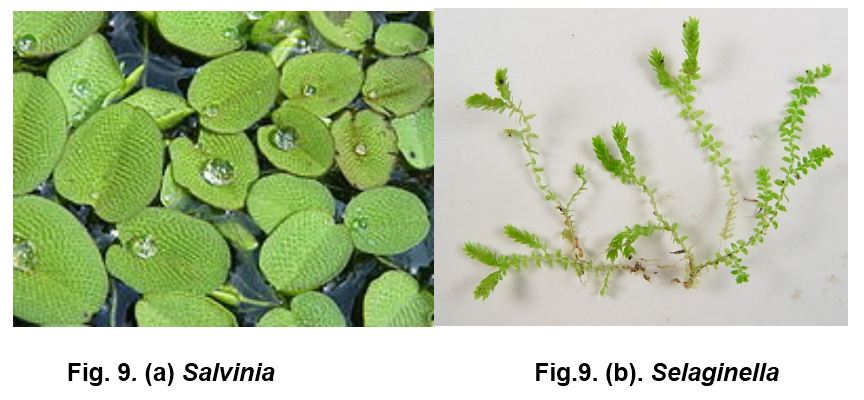
Gymnosperms
They are the seed producing plants. The members of gymnosperms are Cycads, Ginkgo, Gnetophytes, Conifers etc. They are seed producing plants in which seeds are not enclosed by a seed coat.
- They have well developed tap root system. Roots sometimes lives in fungal association with fungus (mycorrhiza).
- Stems can be branched such as in case of Pinus, but it can be un-branched such as in Cycas.
- Needle-like leaves are present Gymnosperms to reduce the surface area. For example, in Conifers.
- Sunken stomata and thick cuticle is found in Conifers.
- Spores are heterosporous. Female spores are known as megaspores whereas male spores are known as microspores. Megaspores are formed in megasporangia whereas microspores are formed in microsporangia. Reduced microspores are known as pollen grains.
- The megaspore mother cell matures to form an ovule. One megaspore mother cell divides meiotically to form four megaspores. Megaspores are enclosed within the megasporangium.
- Megasporangium matures into archegonia or female sex organ.
- Male and female gametophyte are dependent on each other within the sporangia.
- Pollen tube carry male gametes towards the archegonia. Then the fertilization occurs between the male gamete and female gamete. Zygote formed develops into embryo and ovules develop into seeds.
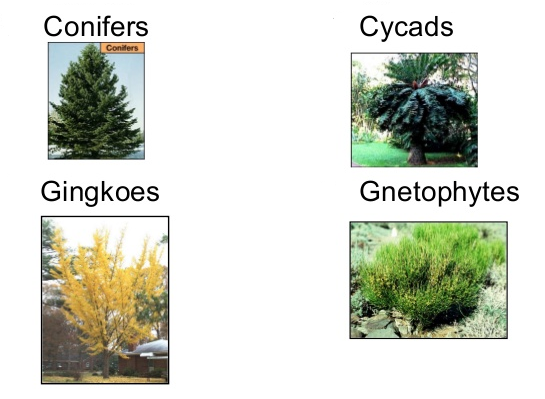
Fig.10. Divisions of Gymnosperms
Angiosperms
They are the flower producing plants. They have seeds enclosed within the seed coat. Seeds are enclosed within the fruit. They are divided into- Dicotyledonous plants and monocotyledonous plants. Dicots are characterized with two cotyledons while monocots have only one cotyledon.
- Male sex organ is stamen. Stamen comprises of anther and the filament. Anther is bilobed and stalk is known as filament. Anther produces male gametes known as pollen grains. Pollen grains are haploid in nature.
- Female sex organ is pistil or carpel. Pistil consists of three parts- stigma, style, and ovary. Stigma is a platform where pollen lands during pollination. Ovary contains many ovules.
- Within ovules are present highly reduced female gametophytes termed embryo sacs.
- Embryo sac undergoes meiosis to form haploid cells. Each embryo sac is 7 celled and 8 nucleated. One egg cell and two synergids are located on one end of embryo sac(micropyle) whereas three antipodals are present on the other end. In the center of the embryo sac two polar nuclei is present. Two polar nuclei fuse to form secondary nucleus. When pollen grains reach the embryo sac, secondary nucleus fuse with haploid pollen grains to form triploid endosperm. The other pollen grain fertilizes the egg to from zygote. This process is known as double fertilization. The end products of double fertilization are diploid zygote and triploid endosperm. Endosperm serves in providing nourishment to the growing embryo. The synergids and antipodals degenerate after fertilization.
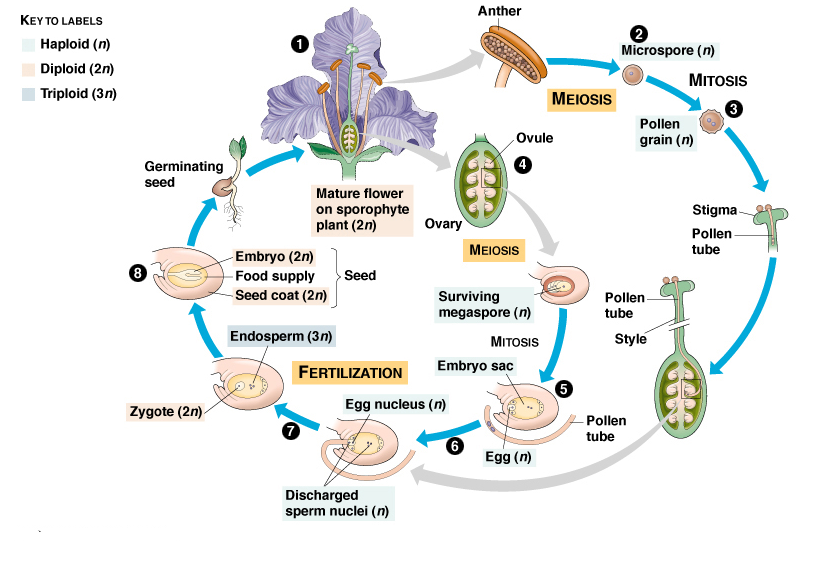
Fig.11. Life cycle of Angiosperms
Plant life cycles and alternation of generations
Plant bodies can be haploid and diploid. The haploid plant body produces haploid male and female gametes. Haploid plant body represent the gametophyte. Meiosis produces haploid spores. So, occurs alternation of generation in plants, that is, life cycle comprises of both haploid and diploid phases.
Different life cycle patterns are as follows-
- Haplontic life cycle- When dominant phase in plants is gametophytic, the life cycle is termed as haplontic life cycle. In this case, no free-living sporophyte is present. The diploid stage is single celled. For example, Volvox, Spirogyra.
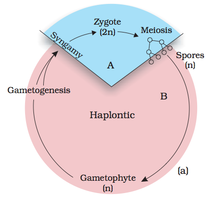
Fig.12. Haplontic life cycle
- Diplontic life cycle- Sporophyte is a diploid, independent and dominant phase. Gametophyte is represented by single to few celled haploid gametophyte. For example, Fucus. Almost all seed-bearing plants follow diplontic life cycle.
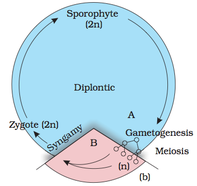
Fig.13. Diplontic life cycle
- Haplodiplontic life cycle– Haploid as well as diploid phase is multicellular. Haploid phase is photosynthetic and independent whereas diploid plant body is partially or completely dependent on gametophyte.
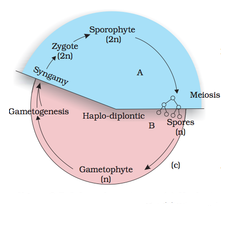
Fig.14. Haplo-diplontic life cycle